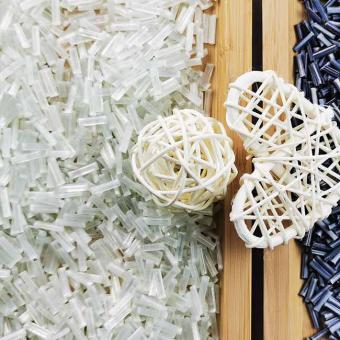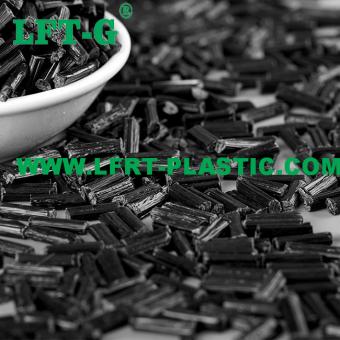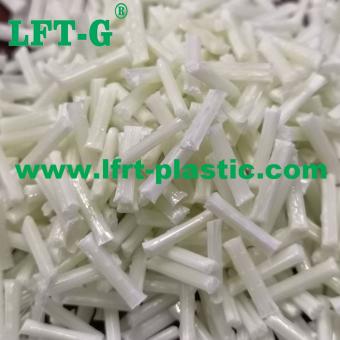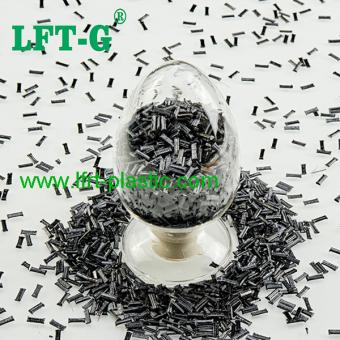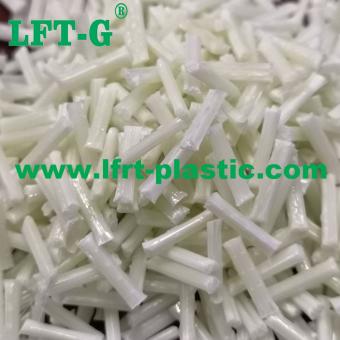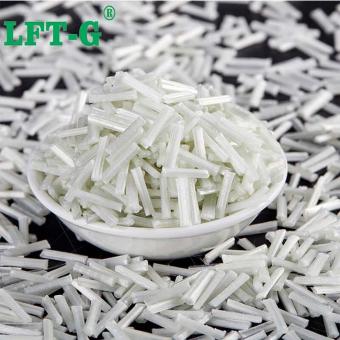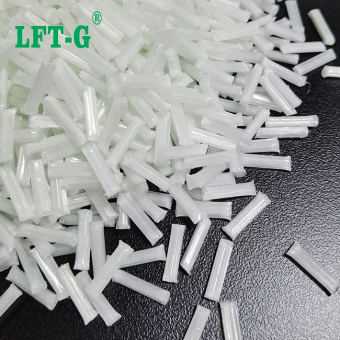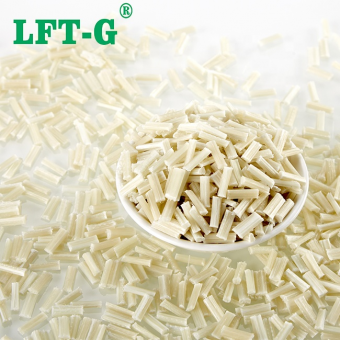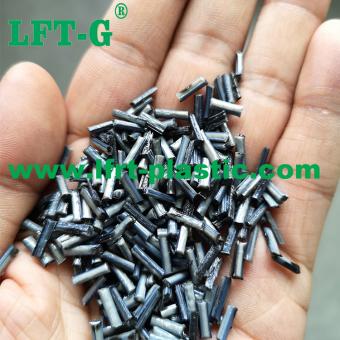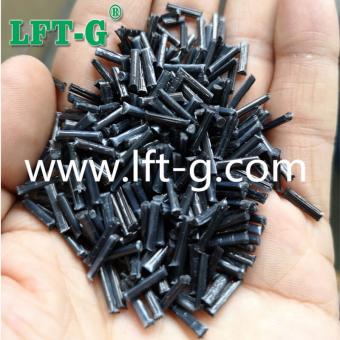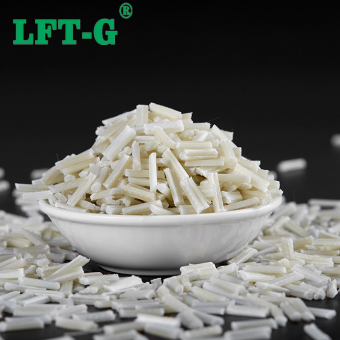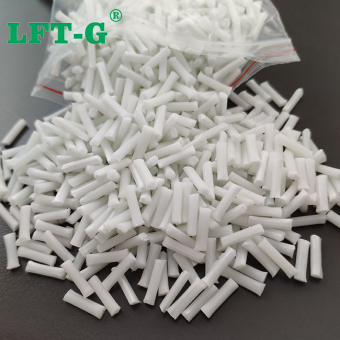-
LFT-G TPU resin filling long glass fiber LGF30 engineering plastics reinforced compounds high tensile strengthTPU introduction Thermoplastic polyurethane (TPU) elastomers are linear polymers formed by the copolymerization of hard and soft chain segments, which have physical properties such as tensile, abrasion and heat resistance, and elasticity similar to rubber. Thanks to the excellent product performance, the application fields of TPU are expanding, including daily consumer goods, construction, medical, military, automotive, agriculture and many other fields. New products and applications are also emerging, such as large-diameter hoses (shale gas extraction), charging cables for new energy vehicles, foamed TPU (ETPU) sports shoes midsoles prepared by supercritical foaming process, invisible braces, etc. Fiber reinforced modified TPU composites TPU has good impact resistance, but in some applications, high modulus of elasticity and very hard material is required. Glass fiber reinforced modification is a common technical means to improve the elastic modulus of the material. Through modification, thermoplastic composites with many advantages such as high elastic modulus, good insulation, heat resistance, good elastic recovery, good corrosion resistance, impact resistance, low coefficient of expansion and dimensional stability can be obtained. Long glass fiber VS Short glass fiber Compared with the short fiber, long fiber has more excellent performance in mechanical properties. It is more suitable for large products and structural parts. It has 1-3 times higher toughness than short fiber, and the tensile strength is increased by 0.5-1 times. Thermoplastics VS Thermosets Thermosets: when heated for the first time, they can soften and flow, and when heated to a certain temperature, they produce a chemical reaction a cross-chain curing and become hard, this change is irreversible, after that, when heated again, they can no longer become soft and flow. Thermoplastic: thermoplastic resin is the main component, and various additives are added to form a plastic. Under certain temperature conditions, plastic can be softened or melted into any shape, and the shape remains unchanged after cooling; this state can be repeated many times and always has plasticity, and this repeated is only a physical change. Advantages Thermosets: Thermoset plastics retain their strength and shape even when heated. This makes thermoset plastics ideal for producing permanent parts and large, strong shapes. In addition, these parts have excellent strength properties (despite their fragility) and do not lose significant strength when exposed to higher operating temperatures. Thermoplastics: Thermoplastics are the most widely used plastics and typically have high chemical and thermal resistance, as well as a high strength structure that is not easily deformed. It is made of thermoplastic resin as the main component with various additives. Thermoplastic products have excellent electrical insulation, with very low dielectric constant and dielectric loss, suitable for high Frequency and high voltage insulation materials. TPU-LGF applications TDS for TPU-LGF Products details Number Length Colour Sample Price MOQ Package Delivery time TPU-NA-LGF30 12mm (can be customized) Natural colour (can be customized) Available Need to be confirmed 25kg 25kg/bag 7-15 days after shipment About us Company Xiamen LFT composite plastic Co., Ltd. is a brand-name company that focuses on LFT&LFRT. Long Glass Fiber Series (LGF) & Long Carbon Fiber Series (LCF). The company's thermoplastic LFT can be used for LFT-G injection molding and extrusion, and can also be used for LFT-D molding. It can be produced according to customer requirements: 5~25mm in length. The company's long-fiber continuous infiltration reinforced thermoplastics have passed ISO9001 &16949 system certification, and the products have obtained lots of national trademarks and patents.
- Low warpage electronic appliance
- tpu lgf30 for toe cap
- self owing tpu pellets
- tpu different resin lgf
- high strength and high toughness reinforced tpu pellets
- self owing tpu pellets polymer
Tags :
-
LFT-G PPS Polyphenylene sulfide composite long carbon fiber thermoplastic resin high rigidity and strengthPPS Information Polyphenylene sulfide (PPS) is not enhanced before modification, its disadvantages are brittle, poor toughness, low impact strength, after filling glass fiber, carbon fiber and other enhancements modified to overcome the above shortcomings, to obtain very good overall performance. PPS filling Long carbon fiber In the modified engineering plastics industry, long fiber reinforced composites are composites made from long carbon fibers, long glass fibers and polymer matrix through a series of special modification methods. The most important feature of long fiber composites is that they have superior performance that the original materials do not have. If we classify them according to the length of the reinforcing materials added, they can be divided into: long fiber, short fiber and continuous fiber composites. Long carbon fiber composites are one kind of long fiber reinforced composites, which are a new fiber material with high strength and high modulus. It is a new material with excellent mechanical properties and many special functions. Corrosion resistance: LCF carbon fiber composite materials have good corrosion resistance and can adapt to the harsh working environment. UV resistance: the ability to resist UV is strong, and the products are less damaged by UV. Abrasion and impact resistance: the advantage of comparing with general materials is more obvious. Low density: lower density than many metal materials, can achieve the purpose of light weight. Other properties: such as reducing warpage, improving rigidity, impact modification, increasing toughness, electrical conductivity, etc. LCF carbon fiber composites have higher strength, higher rigidity, lower weight, and excellent electrical conductivity compared with glass fiber. PPS TDS for reference PPS Application Other products you can also contact us for more technical advice. Q&A 1. Are carbon fiber composite products very expensive? The price of carbon fiber composite products is closely related to the price of raw materials, the level of technology and the number of products. The higher the performance of the raw material, the more expensive it is, such as the carbon fiber PEEK thermoplastic material used in orthopedics. Of course, the more complex the manufacturing process, the greater the working time and workload, and the increased production costs. However, the larger the order quantity, the lower the cost per product. In the long run, the superior performance of carbon fiber will extend the life of the product, reduce the number of maintenance, and is also very beneficial to reduce the cost of use. 2. Are carbon fiber composite products toxic? Carbon fiber composites are made of carbon fiber filaments mixed with ceramics, resins, metals and other substrates, and are generally not toxic. For example, the above-mentioned PEEK material is made of food-grade resin, which is very compatible with the human body and is not only harmless to humans, but also becomes a more ideal material for orthopedic surgery because of its high strength and elastic modulus close to the bone cortex. Carbon fiber medical bed plate, will be in daily contact with many patients body, will not have adverse effects on the human body, on the contrary, for the accuracy of medical diagnosis and a great help. 3. What is the difference between thermosetting carbon fiber composites and thermoplastic carbon fiber composites? Thermoset carbon fiber composites favor the role of curing agent in curing and molding. While thermoplastic carbon fiber composite products mainly rely on cooling down to achieve the shaping. Thermoplastic carbon fiber composites are not as popular as thermoset carbon fiber composites, mainly because they are expensive and are generally used in high-end industries. Thermoset carbon fiber composites are difficult to recycle due to the limitation of the resin matrix itself, and are generally not considered; thermoplastic carbon fiber composites can be recycled, and can be made twice as long as they are heated to a certain temperature. About us We will offer you: 1. LFT & LFRT material technical parameters and leading edge design 2. Mold front design and recommendations 3. Provide technical support such as injection molding and extrusion molding
- PPS polyphenylent
- pps lcf40 granules raw material
- PPS long carbon fiber extrusion
- pps LCf40 plastic injection part
- carbon fibre reinforced pps lcf pellet
Tags :
-
LFT MXD6 LGF composite plastic long glass fiber filling high performance injection molding customized colorMXD6 The conventional aliphatic nylon is easy to process and mold but has strong water absorption and low glass transition temperature; the all-aromatic nylon solves the shortcomings of aliphatic products to a large extent, but the processing difficulty increases exponentially. After 1972, Toyo Textile and Mitsubishi Gas Chemical synthesized a new type of semi-aromatic nylon MXD6, which not only overcame the shortcomings of aliphatic and all-aromatic to a large extent, but also had some advantages of all-aromatic resin. It has a wide range of applications in the fields of packaging materials and engineering structural materials, where gas barrier properties are required. Compared with other materials, MXD6 has the advantages of high strength and elastic modulus, high glass transition temperature, low water absorption and moisture permeability, fast crystallization, easy molding and manufacturing, excellent gas barrier properties, and good barrier to carbon dioxide and oxygen even under high humidity. As an engineering plastic, MXD6 can replace the use of metal materials in the automotive industry, such as power tools, magnetic materials, automotive shells, chassis, beams, engine accessories, etc. The main component of the Reny series of Mitsubishi Gas on the market is MXD6. In addition, as a molding material MXD6 is also used to produce monofilaments and special fibers. Long glass fiber Long glass fiber rovings Glass fiber is an inorganic non-metallic materials with excellent performance, a wide range of advantages is good insulation, heat resistance, corrosion resistance, high mechanical strength, but the disadvantage is the brittle nature, wear resistance is poor. It is made of glass balls or waste glass as raw material by high temperature melting, drawing, yarn, weaving and other processes, its monofilament diameter of a few microns to more than twenty microns, equivalent to a hair of 1/20-1 / 5, each bundle of fiber filaments are composed of hundreds or even thousands of monofilaments. Glass fiber is commonly used as reinforcing materials in composite materials, electrical insulation materials and thermal insulation materials, circuit substrates and other areas of the national economy. Plastics are ubiquitous in everyday life, from common consumer goods to durable goods. To improve the strength of plastics, thermoplastic materials are often reinforced by glass fiber or carbon fiber. In the face of high loads and impact stresses at high and low temperatures, which are often not matched by ordinary short glass fiber materials, polymers begin to soften or become brittle, and long glass fiber reinforced polymers are created. Long glass fiber generally refers to glass fiber with length over 10mm. MXD6 filling Long glass fiber Datasheet for reference Application MXD6-LGF is mainly applied in the large parts. About company Xiamen LFT composite plastic Co., Ltd. is a brand-name company that focuses on LFT&LFRT. Long Glass Fiber Series (LGF) & Long Carbon Fiber Series (LCF). The company's thermoplastic LFT can be used for LFT-G injection molding and extrusion, and can also be used for LFT-D molding. It can be produced according to customer requirements: 5~25mm length. The company's long-fiber continuous infiltration reinforced thermoplastics have passed ISO9001&16949 system certification, and the products have obtained lots of national trademarks and patents. We will offer you: 1. LFT&LFRT material technical parameters and leading edge design 2. Mold front design and recommendations 3. Provide technical support such as injection molding and extrusion molding Quality Management System ISO9001&16949 Certification National Laboratory Accreditation Certification Modified Plastics Innovation Enterprise Honorary Certificate Heavy metal REACH & ROHS testing Welcome to contact us!
- MXD6 LFT-G
- thermoplatic resin lft gfrp
- MXD6 for injection mold engineering plastic
- modified MXD6 high toughness
- lft raw materials MXD6
Tags :
-
LFT-G PEEK engineering plastic fill long carbon fiber 30% composites high rigidity strength for automotive partsPEEK plastic PEEK is a comprehensive performance of excellent special engineering plastics, with excellent heat resistance, chemical resistance, radiation resistance, electrical properties, flame retardant properties, etc.. Its molecular chain is a polymer composed of a benzene ring and connected ketone and ether groups, and the benzene ring ensures that PEEK materials have good rigidity, and the ether bond ensures that PEEK has good toughness, so that PEEK is a comprehensive material with both toughness and rigidity. PEEK has the following outstanding properties: (1) Extremely high heat resistance. Can be used at 250 ° C for a long time, instantaneous use of the temperature up to 300 ° C, at 400 ° C for a short period of time almost no decomposition. (2) excellent mechanical properties and dimensional stability. PEEK can maintain high strength at high temperatures, bending strength at 200°C is still up to 24 MPa, 250°C bending strength and compression strength of up to 12-13 MPa, especially suitable for manufacturing at high temperatures can work continuously in the components. In addition, PEEK also has good creep resistance, can be used in the period of great stress, not due to the extension of time to produce significant extension. (3) Excellent chemical resistance. Even at high temperatures PEEK resists corrosion of most chemicals very well, with corrosion resistance similar to that of nickel steel. The only thing that can dissolve PEEK under normal conditions is concentrated sulfuric acid. (4) Good resistance to hydrolysis. Can resist chemical damage from water or high-pressure water vapor. Under high temperature and pressure conditions, PEEK components can work continuously in aqueous environments while still maintaining good mechanical properties. If immersed in water at 100 ° C for 200 days, the strength remains almost unchanged. (5) Good flame retardant properties. It can reach UL 94 V-0 level, has self-extinguishing property, and releases less smoke and toxic gas under flame condition. (6) Good electrical properties. In a wide range of frequencies and temperatures, PEEK can maintain the same electrical properties. (7) High radiation resistance. PEEK has a very stable chemical structure, in high doses of ionizing radiation PEEK parts can also work properly. (8) Good toughness. Fatigue resistance to alternating stress is the most outstanding of all plastics, comparable to alloy materials. (9) Excellent resistance to friction and wear. It can maintain high wear resistance and low friction coefficient at 250°C. (10) Good processing performance. Easy to injection molding and high molding efficiency. PEEK-LCF compounds Long carbon fiber modified PEEK materials at room temperature, the tensile strength doubled compared to unreinforced, reaching three times at 150°C. At the same time, the reinforced composites also received a substantial increase in impact strength, flexural strength and modulus, with a dramatic reduction in elongation and heat deflection temperatures that can exceed 300°C. The impact energy absorption rate of the composites directly affects the performance of the composites when subjected to impact, and carbon fiber-reinforced peek composites show a specific energy absorption capacity of up to 180 kJ/kg. Application Long carbon fiber modified peek materials are widely used in the fields of aerospace, automotive manufacturing, electrical and electronics, medical and food processing. For example, applied to orthopedic medical devices, thanks to carbon fiber-reinforced PEEK used in orthopedics five major performance advantages: light weight and strength, wear resistance, good biocompatibility, corrosion resistance, good X-ray permeability, it can be done intramedullary nailing PEEK aiming rod bracket, distal locking with PEEK aiming frame, external fixation bracket with X-ray permeable PEEK heel linkage (spark surface), minimally invasive PEEK guided tail (aiming rod), etc. TDS for reference Different properties with different fiber specification The content of long fiber is not more is better. The suitable content is just to meet the requirements of each products. Produce process Our materials are suitable for injection molding and extrusion molding. Parts of Certifications Quality Management System ISO9001/16949 Certification National Laboratory Accreditation Certificate Modified Plastics Innovation Enterprise Honorary Certificate Heavy metal REACH & ROHS testing Q & A Q. Does long glass fiber and long carbon fiber injection have special requirements for injection molding machines and molds? A. There are certainly requirements. Especially from the product design structure, as well as the injection molding machine screw nozzle and mold structure injection molding process must consider the requirements of long fiber. Q. What are the differences and advantages of long fiber materials and thermosets and staple fibers? A. Compared with the short fiber, is has more excellent performanc...
- PEEK LCF 30 composites
- peek injection mold resin materials
- good price peek self factory
- peek conpounds reinforced plastic
- peek low warpage lfrt
- peek CFRP pellets polymers
Tags :
-
LFT-G MXD6 compounds with long glass fiber filler high performance reinforced plastic customized virgin gradeMXD6 materials MXD6 is a crystalline polyamide resin, which is synthesized by condensation of m-phenylenedimethylamine and adipic acid. 1、Maintain high strength and rigidity in a wide temperature range 2、High heat deflection temperature, small coefficient of thermal expansion 3、Low water absorption, small size change after water absorption, less mechanical strength reduction 4、Small shrinkage rate of molding, suitable for precision molding process 5、Excellent paintability, especially suitable for surface painting under high temperature 6、Excellent barrier to oxygen, carbon dioxide and other gases MXD6-LGF materials MXD6 can be laminated with glass and carbon fibers for materials containing 20-60% glass fiber reinforcement with exceptional strength and stiffness. Even when filled with high levels of glass fiber, its smooth, resin-rich surface creates a high gloss surface as without glass fiber, making it extremely suitable for painting, metal coating or generating naturally reflective shells. 1. High fluidity for thin wall It is a very high flowing resin that can easily fill thin walls as thin as 0.5 mm thick even with glass fiber content as high as 60%. 2. Excellent surface finish The resin-rich perfect surface has a highly polished appearance, even with a high glass fiber content. 3. Very high strength and stiffness With 50-60% glass fiber reinforcement, MXD6 has a tensile and flexural strength similar to many cast metals and alloys. 4. Good dimensional stability At ambient temperature, the coefficient of linear expansion (CLTE) of MXD6 glass fiber composites is similar to that of many cast metals and alloys. It is highly reproducible due to low shrinkage and the ability to maintain tight tolerances (length tolerances can be as low as ± 0.05% if properly formed). Datasheet for reference produce processing Extrusion mold Injection mold Frequently asked questions Q. Does long glass fiber and long carbon fiber injection have special requirements for injection molding machines and molds? A. There are certainly requirements. Especially from the product design structure, as well as the injection molding machine screw nozzle and mold structure injection molding process must consider the requirements of long fiber. Q. How to choose the requirement method and length of the material when using long fiber reinforced thermoplastic material? A. The selection of materials depend on the requirements of the products. It is necessary to assess how much the content is enhanced and how much length is more appropriate, which are depending on the performance of the products. Q. Under what circumstances can long fiber replace short fiber? What are the common alternative materials? A. Traditional staple fiber materials can be replaced with long glass fiber and long carbon fiber LFT materials in the case of customers whose mechanical properties cannot be met or where higher metal substitutes are desired. For example, PP long glass fiber is often replacing nylon reinforced glass fiber, and nylon long glass fiber is replacing PPS series. We will offer you 1. LFT & LFRT material technical parameters and leading edge design 2. Mold front design and recommendations 3. Provide technical support such as inejction molding and extrusion molding Main products
- mxd6 granules lgf30
- lft-g mxd6 conposite plastic glass fiber
- injection mxd6 best price compounds
- thermoplastic resin pa12 with fiber
- low warpage electronic appliance
- mxd6 for engineering plastic long fiber
Tags :
-
LFT-G Polyamide 6 nylon materials filling glass fiber 20%-60% high mechanical properties sample availablePolyamide 66 filling long glass fiber PA66 is one of the most produced and widely used polyester series products. It has high grain size, excellent tensile properties, bending properties, tensile strength and other material mechanical properties, and its excellent ultra-low temperature characteristics and organic chemical properties. It is a class of rubber products with wide range of application, stable characteristics, good mechanical properties, high quality insulation, low density, easy processing and molding, self-extinguishing, and good wear resistance. Therefore, it is widely used in vehicles, electronic and electrical, chemical materials, industrial equipment, instrument panels, construction projects and other industries. However, it has high water absorption, poor alkali resistance, dry ultra-low temperature impact, low compressive strength and easy to deform after absorbing moisture, which affects the reliability of goods specifications. People have improved PA66 in a variety of ways, adding PA66 chemical fiber is one of them. After adding glass fiber, its impact force, heat deformation, material mechanical properties, molding processability and acid resistance are significantly improved. Glass fiber is a class of functional raw materials with high quality characteristics. This utility model has the advantages of low cost, non-combustibility, high temperature resistance, acid resistance, high tensile strength, high impact compressive strength, low tensile strength, high quality insulation properties, high quality insulation properties, etc. It is usually used as a raw material to improve organic chemical polymers or functional materials and composites. The most important hazard of proportional limits to raw materials is mechanical properties. The material mechanical properties of modified PA66 are also related to the composition of glass fibers. The tensile strength, bending strength and impact compression strength of PA66 increase with the glass fiber composition after the addition of PA66 chemical fibers. The tensile and flexural strengths of the managed system increased linearly, but the glass fiber composition was 30%. The trend of increasing tensile and flexural strengths showed some improvement. The results show that PA66 can produce a reasonable page layer, which can reasonably transfer the ground stress between the matrix and page, and thus improve the compressive strength of the matrix. Datasheet for reference Test Certifications Factory Xiamen LFT composite plastic Co., Ltd Xiamen LFT composite plastic Co., Ltd. is a brand-name company that focuses on LFT&LFRT. Long Glass Fiber Series (LGF) & Long Carbon Fiber Series (LCF). The company's thermoplastic LFT can be used for LFT-G injection molding and extrusion, and can also be used for LFT-D molding. It can be produced according to customer requirements: 5~25mm length. The company's long-fiber continuous infiltration reinforced thermoplastics have passed ISO9001&16949 system certification, and the products have obtained lots of national trademarks and patents. Main products
- pa66 nylon fill lgf home appliance parts
- pa66 compounds for electronic parts
- low warpage PA66 composite glass fiber
- thermoplastic resin pa66 with fiber
- electronic appliance part materials pa66 long fiber
- pa66 nylon filling long fiber white
Tags :
-
LFT-G PP compunds filling long glass fiber polymers high rigidity low warpage instead metal for home appliance partsPP-LGF compounds Long glass fiber reinforced polypropylene composites belong to a kind of long glass fiber reinforced thermoplastics, the main preparation materials are continuous long glass fiber and polypropylene. and polypropylene. Long glass fiber reinforced polypropylene composites have longer glass fiber length, high strength, low density, high impact performance, its rigidity, strength, creep and other properties better than conventional fiber reinforced polypropylene composites. The role of glass fiber reinforced materials in glass fiber reinforced polypropylene composites is to carry loads, and the specific load-bearing properties are related to the proportion of glass fiber reinforced materials in the material, length, orientation and other factors. In the preparation process, it is found that, under the condition of unchanged preparation technology, the increase of the proportion of glass fiber reinforced material in the material will shorten the length of the material, and the bending property, tensile property, and strength of the material will be increased; when the proportion reaches 50%, the various mechanical properties of the material will reach the best. PP-LGF application In automotive engineering, instrument panels, front-end components and underbody elements are increasingly made of glass-fiber-reinforced polypropylene. Polypropylene is characterized by low density, low material costs and ease of reuse, and is therefore gradually replacing engineering plastics and metals in these applications. Glass fiber reinforced composites can significantly enhance the durability, rigidity, toughness, creep, etc. of the original material, the current glass fiber reinforced composites are increasingly widely used in automotive parts.LGF polypropylene composites can solve the traditional short glass fiber reinforced materials are easy to warp, poor low-temperature toughness, fatigue resistance is generally shortcomings such as LGF polypropylene composites, LGF polypropylene composites in the glass fiber retention length is longer, with a high specific strength, LGF polypropylene composites have longer retained glass fiber length, high specific strength, high specific modulus, strong impact resistance, dimensional stability and low warpage, etc. Therefore, LGF polypropylene materials are used to replace parts produced by traditional PA-SGF, PBT-SGF and other materials. Further weight and cost reductions are realized. LGF polypropylene can be used for engine hoods, front-end modules, instrument panel frames, tailgates, battery trays, and door liner modules. Datasheet for reference Details Grade Fiber specification Mian characteristics Applications General grade 30%-60% Chemical coupling,high strength Automobile parts, washing machine parts, water pump parts, water treatment parts, furniture, etc. Heat-resistance grade 30%-60% High strength, long-term heat aging resistance Automobile front and rear end modules, water tank frames, battery brackets, hood covers, sunroof frames, etc. UV-resistance grade 30%-60% High strength, UV resistance, long term heat aging resistance, good product appearance Car (truck) door handles, mirror systems, battery housings, truck (SUV) exterior pedals, etc. Toughten resistance grade 30%-60% Ultra-high impact strength (at normal and low temperatures) Power tools, pump housings, pipe fittings, etc. Other materials you may wonder PA6-LGF TPU-LGF PA12-LGF Frequently asked questions Q. Does long glass fiber and long carbon fiber injection have special requirements for injection molding machines and molds? A. There are certainly requirements. Especially from the product design structure, as well as the injection molding machine screw nozzle and mold structure injection molding process must consider the requirements of long fiber. Q. Using a long fiber reinforced thermoplastic material, will it block the die hole due to the long length of the fiber or not? A. When using long glass fiber or long carbon fiber, it is necessary to evaluate whether the product is suitable for LFT-G. If the product is too small or the dispensing is not suitable for long fiber materials. The long fiber itself has requirements for the mold nozzle. Q. How to choose the reinforcement method and length of the material when using long fiber reinforced thermoplastic material? A. The selection of materials depend on the requirements of the products. It is necessary to assess how much the content is enhanced and how much length is more appropriate, which are depending on the performance requirements of the products.
- Polypropylene filled lgf 30 40 50
- reinforced pp virgin grade plastic
- PP recycled for car parts electric parts
- PP composite pellets Polymer granules
- thermoplastic resin PP with fiber
Tags :
-
LFT-G high performance PA6 Polyamide6 compounds long glass fiber instead metal original color sample availablePolyamide 66 plastic PA66 melting point 260~265℃, glass transition temperature (dry state) is 50℃. Density is 1.13~1.16 g/cm3. PA66 has low water absorption, excellent dimensional stability and high rigidity. Higher melting point, can be used for a long time in harsh environments, in a wide range of temperatures can still maintain sufficient stress, continuous use temperature of 105 ℃. Long glass fiber reinforced composite Glass fiber reinforced plastic is based on the original pure plastic, filling glass fibers and other additives, so as to improve the scope of use of the material. Generally speaking, most of the glass fiber reinforced materials are used in the structural parts of the products, which is a kind of structural engineering materials, such as: PP, ABS, PA66, PA6, TPU, PPA, PBT, PEEK, PBT, PPS and so on. Advantages 1)After glass fiber reinforcement, glass fiber is a high temperature resistant material, therefore, the heat-resistant temperature of reinforced plastics is much higher than before without glass fiber, especially nylon plastics. 2)After the glass fiber reinforcement, due to the addition of glass fiber, the plastic polymer chain is restricted to move with each other, therefore, the shrinkage of reinforced plastics decreases a lot, and the rigidity is greatly improved. 3)After glass fiber reinforced, the reinforced plastic will not stress cracking, at the same time, the impact resistance of the plastic improves a lot. 4)After the glass fiber reinforcement, the glass fiber is a high strength material, which also greatly improves the strength of the plastic, such as: tensile strength, compression strength, bending strength, improve a lot. 5)After glass fiber reinforcement, due to the addition of glass fiber and other additives, the combustion performance of the reinforced plastics decreases a lot, most of the materials can not be ignited, it is a kind of flame-retardant material. Datasheet for reference Applications PA66's comprehensive performance is good, with high strength, good rigidity, impact resistance, oil and chemical resistance, abrasion resistance and self-lubricating advantages, especially hardness, rigidity, heat resistance and creep performance is better. Datails Grade Fiber specification Main characteristics Applications General grade 20%-60% high toughness (especially at low temperatures), excellent creep and fatigue resistance, low warpage Automobiles, electronic and electrical appliances, sports equipment, power tools, high-speed rail parts, etc. Toughen resistance grade 20%-50% high impact strength, light texture Automobiles, electronic appliances, sports equipment, power tools, tool handles, high-speed rail parts, gears, etc. Lab & Factory About company Xiamen LFT Composite Plastic Co.,LTD was established in 2009, is a brand-name global suppliers of long fiber reinforced thermoplastic materials integrating product research & development(R&D), production and sale marketing. Our LFT products have passed the ISO9001&16949 system certification and have obtained lots of national trademarks and patents, covering the fields of automotive, military parts and firearms, aerospace, new energy, medical equipment, power wind energy, sports equipment, etc.
- PA66 Nylon pellets reinforced plastic
- polyamide 6 engineering plastics lgf
- Low warpage modified PA6 LGRF
- injection mold PA66 auto parts polymers
- Nylon composite pellets Polymer granules
- long glass fiber reinforced plastic pa66
Tags :
-
LFT-G PEEK high quality modified materials fill long carbon fiber for automotives good performanceThroughout the plastics industry, PEEK is widely recognized as a leading high performance polymer (HPP). However, the preferred material in the automotive, aerospace, oil and gas, and medical device industries has long been metal, and PEEK polymers are rapidly changing that mindset. What is the PEEK material PEEK or Polyetheretherketone belongs to the class of polymers known as "aromatic polyketones" (more accurately Polyaryletherketone or PAEK). Research and development of PEEK began in the 1960s, but it wasn't until 1978 that Imperial Chemical Industries (ICI) patented PEEK, and Victrex PEEK polymer was first commercialized in 1981. "Aromatic" usually implies a distinctive or sweet flavor, which may seem like an odd term, but scientists use it to describe certain molecules that contain or consist of a cyclic structure (such as the aryl unit above). Small molecules of this type, such as toluene and naphthalene, have distinctive odors and hence the name. However, PEEK itself, like most thermoplastics, is odorless under normal conditions. Chemically, PEEK is primarily a linear semi-crystalline polymer. P comes from the Greek word "poly" meaning "many", so many EEKs form PEEK. aryl and ketone groups provide stiffness by being somewhat rigid, which means good mechanical properties and a high melting point. The ether group provides a degree of flexibility, while the aryl and ketone groups are chemically inert and thus chemically resistant. The regular structure of the repeating units means that the PEEK molecule can be partially crystallized and the crystallinity provides properties such as wear resistance, creep resistance, fatigue resistance and chemical resistance. The resulting polymer is widely recognized as one of the best performing thermoplastics in the world. Compared to metals, PEEK-like materials are lightweight, easy to mold, corrosion-resistant, and have a fairly high specific strength (strength per weight). Datasheet for reference When high performance is required, PEEK as the polymer of choice offers more than just two or three properties, it offers a wide range of excellent properties including: - High heat resistance Testing has shown that LFT-G's PEEK polymer has a continuous use temperature of 260°C (500°F). This allows for a wide range of applications in hot corrosive environments such as the process industry, oil and gas industry, and the engines and transmissions of countless vehicles.PEEK resists friction and wear in dynamic applications such as thrust washers and seals. - Chemically Inert PEEK resists damage caused by chemically corrosive working environments such as downhole environments in the oil and gas industry, and gears in mechanical and automotive applications. It is resistant to jet fuels, hydraulic fluids, de-icers and pesticides used in the aerospace industry for a wide range of pressures, temperatures and time frames. - Strong mechanical properties PEEK exhibits excellent strength and stiffness over a wide range of temperatures, and the specific strength of PEEK-like carbon fiber composites is many times higher than that of metals and alloys. "Creep" is the permanent deformation of a material under constant stress over a period of time. "Fatigue" is the brittle destruction of a material under repeated cyclic loading. Because of its semi-crystalline structure, PEEK has high creep and fatigue resistance and is more durable than many other polymers and metals over a long service life. - Does not ignite or burn easily PEEK has excellent flame resistance, with an ignition temperature of nearly 600°C. Even when ignited at very high temperatures, it does not burn continuously and emits little smoke. This is one of the reasons why PEEK is widely used in commercial aircraft. - Reprocessable and recyclable PEEK molecules are so stable that they can be melted and reprocessed time and time again with minimal impact on their properties. This helps to improve the environmental footprint and ensures more efficient reuse of waste materials generated during the manufacturing process. - And there's more! PEEK is also non-hygroscopic, so its properties are not altered in wet environments; it is resistant to gamma and electron beam radiation and is transparent under X-ray exposure, making it attractive for medical device applications.PEEK is also electrically stable and is typically used as an electrical insulator, but can be modified to become a conductor or static dissipative material. As a thermoplastic PEEK, it can be injection molded, compression molded and extruded using conventional thermoplastic processing equipment. It is very versatile and its use is becoming more and more common to improve component performance, durability, reduce weight and lower overall system costs over its lifetime. There is no doubt that it is replacing metals and alloys. In many industries and critical environments, material specialists, part designers and buyers must choose between PEEK and traditional metals a...
- High performancePEEK fiiler lcf
- Injection molded PEEK good price
- composite plastic peek black color
- made in China peek reinforced materials
- aerospace automotive parts plastic
- Low warpage PPS reinforced long carbon fiber
Tags :
-
Lft-g PA12 raw material filled long carbon fiber new plastic higher performance original color sample freePolyamide 12 material Polyamide (PA), commonly known as nylon, is a diverse group of polymers that are used as engineering plastics to replace metals to meet downstream industrial requirements for lightweight, low-cost products. The materials of the polyamide series exhibit resistance to high temperatures and electrical resistance. Due to their crystalline structure, they also show excellent chemical resistance. They have very good mechanical and barrier properties. In addition, these materials are very flame retardant. Polyamides were the first truly commercial synthetic fibers. When reinforced with carbon fibers (staple or long), their stiffness can compete with that of metals, which is why polyamides are often considered in metal replacement projects. Polyamides are widely used in the automotive, transportation, electronics, electrical, and consumer goods markets. Main properties of PA12: Excellent chemical resistance Low temperature impact resistance Aging resistance High temperature resistance Even if they do not excel in temperature resistance (HDT, peak temperature...) they show stable performance over time even if they do not excel in terms of temperature resistance (HDT, peak temperature...) Their excellent durability allows them to be used in a wide range of conditions (temperature, pressure, chemical ......) PA12 is particularly suitable for situations where long-term stability is required. Application More application fields you can contact us for technical advice. Details Number Color Length Sample Package MOQ Port of Loading Delivery time PA12-NA-LCF Natural color/Customized 6-25mm Available 20kg/bag 20kg Xiamen Port 7-45 days after shipment Produce processing Tests Contact us for more materials
- pa12 lcf pallets black
- Long carbon fiber Reinforced Polyamide12 for electrial accessories
- automotive parts materials PA12
- Nylon 12 composite pellets Polymer granules
Tags :
-
lft-g PBT modified plastic filling long fiber high performance natural color industrial use injection moldedPBT materials Polybutylene terephathalate (PBT) is a crystalline thermoplastic engineering plastic made by polymerizing dimethyl terephthalate (DMT) and 1,4 butanediol (1,4-Butanediol). Due to the growth of the -CH2- chain of PBT resin, the molecular chain is easy to flex, so the glass transfer temperature is lower than that of PET, and the crystallization speed increases. PBT can also be called thermoplastic polyester plastics, applicable to different processing industries, generally more or less will add additives, or blended with other plastics, with different proportions of additives, can be manufactured with different specifications of the product. Because PBT has heat resistance, weather resistance, chemical resistance, good electrical properties, low water absorption, good gloss, widely used in electronic and electrical appliances, automotive parts, machinery, household goods, etc.. PBT's downstream applications include the automotive, electronics/electrical appliance, and machinery industries. Datasheet for reference Application LGF & SGF Advantages of Long glass fiber reinforced materials Glass fiber reinforced plastic is based on the original pure plastic, adding glass fibers and other additives, so as to improve the scope of use of the material. Generally speaking, most of the glass fiber reinforced materials are used in the structural parts of the products, which is a kind of structural engineering materials, such as: PP, ABS, PA66, PA6, PC, POM, PPO, PET, PBT, PPS and so on. Advantages After glass fiber reinforcement, glass fiber is a high temperature resistant material, therefore, the heat-resistant temperature of reinforced plastics is much higher than before without glass fiber, especially nylon plastics. After glass fiber reinforcement, due to the addition of glass fiber, it restricts the mutual movement of the polymer chain of the plastic, therefore, the shrinkage of the reinforced plastic decreases a lot and the rigidity is greatly improved. After glass fiber reinforced, the reinforced plastic will not stress cracking, at the same time, the impact resistance of the plastic improves a lot. After the glass fiber reinforcement, the glass fiber is a high strength material, which also greatly improves the strength of the plastic, such as: tensile strength, compression strength, bending strength, improve a lot. After glass fiber reinforcement, due to the addition of glass fiber and other additives, the combustion performance of the reinforced plastics decreases a lot, most of the materials can not be ignited, it is a kind of flame-retardant material. Warehouse & Lab Customers & Us Catalog
- pbt recycle long fiber granules
- PBT pellets lgf 30 polymer
- LFT materials PBT green materials
- 12mm pellets pbt high toughness
- made in China high performance PBT
Tags :
-
LFT-G xiamen ABS self-factory LGF filling light parts 10-12mmWhat is the modified plastic? Modified plastics are materials with uniform appearance obtained by filling, toughening, reinforcing, blending, alloying and other technical means, with primary form resin as the main component, and additives or other resins that can improve the performance of the resin in mechanics, rheology, combustion, electro-thermal, photomagnetic and other aspects as the auxiliary component. In recent years, the scale of modified plastics industry continues to expand. Modified plastics is a symbol of high-tech, high-performance and high-grade in plastic products, and is widely used in many fields such as aerospace, automobile manufacturing, household appliances, etc., of which the proportion of usage in the automobile field is more than 19%, second only to the home appliance industry, which has the highest usage. In recent years, the use of modified plastics in automobiles has been rising year by year, and the amount of modified plastics used in a single car has become a symbol of the level of automobile design and manufacturing. Divided from the varieties, the amount of plastic varieties are polypropylene (PP), polyamide (PA), acrylonitrile-butadiene-styrene plastics (ABS)), etc., especially PP, PA, ABS, the most abundant automotive modification. From the application point of view, modified plastics are widely used in automotive interior and exterior parts, structural parts and functional parts. Among them, the interior parts are center console, dashboard, decorative panels; exterior parts are air grille, bumper and decorative parts; structural parts are front-end frame, column skeleton; functional parts are lamps, intake manifolds, fuel tanks, etc. are modified plastics used in a large number of automotive parts. What is the Long glass fiber compounds? Glass fiber reinforced plastic is based on the original pure plastic, adding glass fibers and other additives, so as to improve the scope of use of the material. Generally speaking, most of the glass fiber reinforced materials are used in the structural parts of the products, which is a kind of structural engineering materials, such as: PP, ABS, PA66, PA6, PC, POM, PPO, PET, PBT, PPS and so on. Advantages After glass fiber reinforcement, glass fiber is a high temperature resistant material, therefore, the heat-resistant temperature of reinforced plastics is much higher than before without glass fiber, especially nylon plastics. After glass fiber reinforcement, due to the addition of glass fiber, it restricts the mutual movement of the polymer chain of the plastic, therefore, the shrinkage of the reinforced plastic decreases a lot and the rigidity is greatly improved. After glass fiber reinforced, the reinforced plastic will not stress cracking, at the same time, the impact resistance of the plastic improves a lot. After the glass fiber reinforcement, the glass fiber is a high strength material, which also greatly improves the strength of the plastic, such as: tensile strength, compression strength, bending strength, improve a lot. After glass fiber reinforcement, due to the addition of glass fiber and other additives, the combustion performance of the reinforced plastics decreases a lot, most of the materials can not be ignited, it is a kind of flame-retardant material.
- ABS polymers pellets injection molding
- long fibre reinforced thermoplastics
- pellets abs free samples recycled
- extrusion molded low warpage high mechanical properties
- abs injection instead metal high quality
- hot sell best price ABS materials
Tags :

 e-mail
e-mail English
English français
français Deutsch
Deutsch русский
русский italiano
italiano español
español português
português العربية
العربية 日本語
日本語 한국의
한국의 中文
中文












